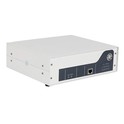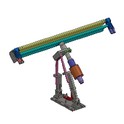Can the ResoLab - Lab Grade Ultrasonicator be used for ultrasonic modification of surfaces?
In the realm of materials science and surface engineering, the concept of surface modification has gained significant traction. Surface modification is a process that alters the properties of a material's surface to enhance its performance in various applications, such as improving adhesion, corrosion resistance, and biocompatibility. Ultrasonic technology has emerged as a promising tool for surface modification, offering a non - invasive and efficient approach. As a supplier of ResoLab - Lab Grade Ultrasonicator, I am often asked whether our products can be used for ultrasonic modification of surfaces. In this blog, I will delve into this question and provide a comprehensive analysis.
Understanding Ultrasonic Surface Modification
Ultrasonic surface modification relies on the high - frequency sound waves generated by an ultrasonicator. When these sound waves propagate through a liquid medium, they create alternating high - and low - pressure cycles. During the low - pressure phase, tiny bubbles form in the liquid, a phenomenon known as cavitation. These bubbles grow until they reach a critical size and then collapse violently during the high - pressure phase. This collapse releases a tremendous amount of energy in the form of shockwaves, microjets, and high - temperature spots.
The energy released during cavitation can have several effects on the surface of a material. It can remove contaminants, roughen the surface, induce phase transformations, and even promote the deposition of new materials on the surface. For example, in the case of metal surfaces, ultrasonic cavitation can remove oxide layers and create a micro - rough surface, which can improve the adhesion of coatings.


Features of ResoLab - Lab Grade Ultrasonicator
Our ResoLab - Lab Grade Ultrasonicator series, including the ResoLab - 1000 Lab Grade Ultrasonicator, ResoLab - 500 Lab Grade Ultrasonicator, and ResoLab - 2000 Lab Grade Ultrasonicator, is designed to provide precise and reliable ultrasonic energy. These ultrasonicators offer a wide range of power outputs, frequency settings, and pulse modes, allowing users to tailor the ultrasonic parameters according to the specific requirements of their surface modification processes.
The ResoLab ultrasonicators are equipped with advanced transducers that can efficiently convert electrical energy into ultrasonic energy. The transducers are made of high - quality piezoelectric materials, which ensure stable and consistent performance over a long period. Additionally, the ultrasonicators have a user - friendly interface, making it easy for operators to adjust the settings and monitor the process.
Applications of ResoLab Ultrasonicator in Surface Modification
Cleaning and Degreasing
One of the most common applications of ultrasonic surface modification is cleaning and degreasing. The cavitation bubbles generated by the ResoLab ultrasonicator can penetrate into small crevices and pores on the surface of a material, dislodging dirt, oil, and other contaminants. This is particularly useful in industries such as automotive, aerospace, and electronics, where clean surfaces are essential for proper component performance.
For example, in the automotive industry, engine components can be cleaned using our ultrasonicator to remove carbon deposits and oil residues. This not only improves the performance of the engine but also extends its lifespan.
Surface Roughening
Ultrasonic cavitation can also be used to roughen the surface of a material. By adjusting the ultrasonic parameters, such as power and frequency, the intensity of cavitation can be controlled to achieve the desired surface roughness. Surface roughening is beneficial in applications where improved adhesion is required, such as in the bonding of polymers to metals or the application of coatings.
In the field of medical devices, for instance, surface roughening of implants using our ResoLab ultrasonicator can enhance the integration of the implant with the surrounding tissue, reducing the risk of rejection.
Surface Alloying and Coating Deposition
Another exciting application of our ResoLab ultrasonicator in surface modification is surface alloying and coating deposition. The high - energy shockwaves and microjets generated during cavitation can mix different materials at the surface, leading to the formation of alloy layers. Additionally, the cavitation can promote the deposition of coatings on the surface by enhancing the mass transfer of coating materials.
For example, in the production of corrosion - resistant coatings, our ultrasonicator can be used to deposit a thin layer of protective material on the surface of a metal substrate. The ultrasonic energy ensures a uniform and well - adhered coating, improving the corrosion resistance of the material.
Advantages of Using ResoLab Ultrasonicator for Surface Modification
There are several advantages to using our ResoLab - Lab Grade Ultrasonicator for ultrasonic surface modification. Firstly, it is a non - invasive process, which means that it does not damage the bulk properties of the material. This is particularly important for delicate materials or components with complex geometries.
Secondly, the ResoLab ultrasonicator offers a high degree of control over the surface modification process. Users can adjust the ultrasonic parameters to achieve the desired surface properties, such as roughness, composition, and morphology.
Thirdly, our ultrasonicator is energy - efficient. It consumes less power compared to other surface modification techniques, making it a cost - effective solution for both small - scale research laboratories and large - scale industrial production.
Challenges and Considerations
While the ResoLab ultrasonicator shows great potential for ultrasonic surface modification, there are also some challenges and considerations that need to be taken into account. One of the main challenges is the optimization of ultrasonic parameters. Different materials and surface modification applications require different ultrasonic settings, and finding the optimal parameters can be a time - consuming and iterative process.
Another consideration is the compatibility of the liquid medium with the material being modified. The liquid medium should be chosen carefully to ensure that it does not react with the material and that it can support the cavitation process effectively.
Conclusion
In conclusion, the ResoLab - Lab Grade Ultrasonicator can indeed be used for ultrasonic modification of surfaces. Its advanced features, such as precise parameter control, efficient energy conversion, and user - friendly interface, make it a suitable tool for a wide range of surface modification applications, including cleaning, roughening, alloying, and coating deposition.
If you are interested in exploring the potential of our ResoLab ultrasonicator for your surface modification needs, we encourage you to contact us for further discussion and procurement. Our team of experts is ready to provide you with detailed information and technical support to help you achieve the best results.
References
- Thompson, D. O., & Chimenti, D. E. (Eds.). (2017). Nondestructive evaluation of materials and structures: fundamentals, techniques, and applications. CRC Press.
- Suslick, K. S., & Flannigan, D. J. (2008). Ultrasound: Its chemical, physical, and biological effects. Royal Society of Chemistry.
- Povey, M. J. W. (1997). Ultrasonics in the chemical industry. Royal Society of Chemistry.






